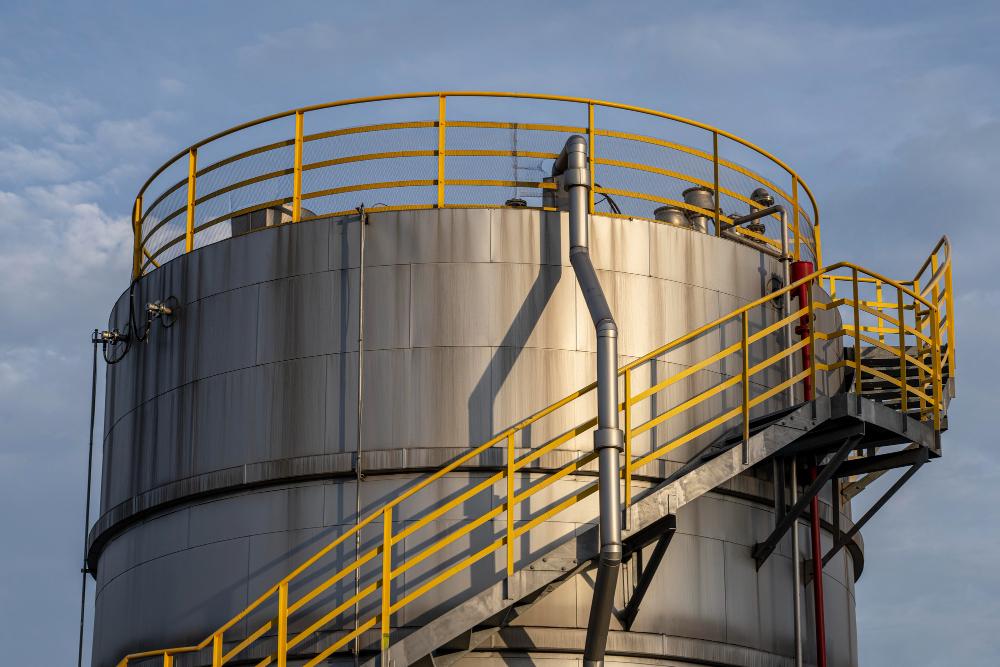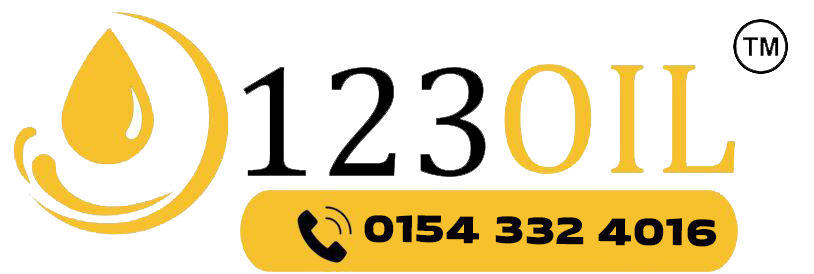A bunded oil tank is a double-walled fuel storage system designed to prevent leaks and environmental contamination. It features an inner tank that holds the oil and an outer tank (the bund) that acts as a secondary containment layer. If the inner tank leaks, the outer bund captures the oil, preventing spills. Bunded tanks are safer, more durable, and often required by UK regulations, especially for properties near water sources or storing over 2,500 litres of oil.
A bunded oil tank is an essential part of safe and efficient domestic oil storage, particularly in homes using heating oil. It’s designed with two protective layers, ensuring that if the inner tank leaks, the outer one, known as the bund, captures the escaping oil. This simple yet effective design helps prevent environmental contamination and makes bunded tanks the preferred choice for most modern oil heating systems in the UK.
Understanding the Structure of a Bunded Oil Tank
A bunded oil tank consists of two layers:
- Inner tank: holds the heating oil.
- Outer tank (bund): acts as a secondary containment barrier.
The bund space can typically hold at least 110% of the oil stored in the inner tank, offering a vital layer of protection against leaks and spills. This makes it especially useful in sensitive areas near waterways, farms, or where local environmental regulations demand higher safety standards.
Why Bunded Oil Tanks Are Important
The importance of a bunded oil tank lies in its ability to protect both the environment and property. A single oil leak can cause soil and groundwater contamination, resulting in costly cleanup and legal issues. With a bunded design, you have peace of mind that any accidental leak will remain contained within the tank system.
In addition, the UK’s Environmental Agency and OFTEC often recommend or even require bunded oil tanks for certain installations, especially in commercial, agricultural, or high-risk residential areas.
Key Features of a Bunded Oil Tank
Modern bunded oil tanks come with advanced features to improve safety, monitoring, and longevity:
- Double-layered protection: The two walls ensure superior containment compared to single-skin tanks.
- Overfill prevention valve: Prevents accidental spillage during refuelling.
- Lockable lids and caps: Enhance security and reduce the risk of fuel theft.
- Tank gauge: Allows users to monitor oil levels easily.
- UV-stabilised materials: Increases durability against weather and sunlight exposure.
These features collectively ensure safe, reliable, and long-lasting performance, making bunded oil tanks a smart investment for heating oil users.
How a Bunded Oil Tank Works
When you fill your tank with heating oil, the fuel is stored in the inner container. If the inner tank were ever to develop a leak, the outer tank (bund) acts as a secondary safety net, containing the oil before it can escape into the surrounding area. Some bunded tanks also include drainage systems and alarms to alert homeowners to leaks or overfills.
This design not only prevents contamination but also helps reduce oil wastage and keeps your heating system working efficiently throughout the year.
Types of Bunded Oil Tanks
Bunded oil tanks come in several shapes, sizes, and materials to suit different domestic and commercial needs:
Plastic Bunded Tanks
- Lightweight and rust-resistant.
- Cost-effective and easy to install.
- Ideal for residential use.
- Lifespan: around 10–15 years with proper maintenance.
Steel Bunded Tanks
- More robust and durable.
- It can withstand harsh weather and impact.
- It is often preferred for commercial or agricultural use.
- Lifespan: 15–25 years, depending on care and installation.
Slimline and Vertical Bunded Tanks
- Designed for limited space.
- Provide flexible installation options for tight areas.
- Offer the same double protection in compact form.

Legal Requirements for Bunded Oil Tanks
In the UK, bunded tanks are often a legal requirement depending on your property’s circumstances. For example, a bunded tank may be mandatory if:
- Your tank capacity exceeds 2,500 litres.
- The tank is located within 10 metres of a watercourse or 50 metres of a well or borehole.
- The tank is used for commercial or agricultural purposes.
- The oil tank is placed in a sensitive environmental area.
The regulations are designed to protect both your property and the surrounding environment from potential oil leaks.
Advantages of a Bunded Oil Tank
A bunded oil tank provides multiple benefits that make it a worthwhile upgrade over single-skin tanks:
- Environmental protection: Prevents leaks from contaminating soil and water.
- Increased safety: Reduces the risk of accidental spills and fire hazards.
- Long-term savings: Minimises costly cleanup, repairs, and oil losses.
- Regulatory compliance: Meets environmental standards and legal requirements.
- Durability: Resistant to weather and corrosion, ensuring a longer lifespan.
These features make bunded oil tanks ideal for anyone seeking a safer and more sustainable heating oil solution.
Disadvantages of a Bunded Oil Tank
While bunded oil tanks offer superior protection, there are a few considerations to keep in mind:
- Higher upfront cost compared to single-skin tanks.
- The product has a slightly larger footprint due to the double-wall construction.
- Maintenance and inspection are important to ensure the bund remains effective.
Despite these minor drawbacks, the added security, longevity, and compliance far outweigh the initial investment for most homeowners.
Maintenance Tips for Bunded Oil Tanks
To keep your bunded oil tank in excellent condition and extend its lifespan, follow these maintenance tips:
- Inspect regularly for cracks, corrosion, or damage to both inner and outer tanks.
- Clean the bund area to remove water, debris, or oil residue.
- Check gauges and fittings to ensure accurate readings and secure connections.
- Schedule professional servicing at least once a year by an OFTEC-registered technician.
- Protect your tank from UV exposure using shade or a protective coating if it is outdoors.
Proper care ensures your oil tank continues to operate safely and efficiently for many years.
Bunded Oil Tanks vs. Single-Skin Tanks
Feature | Bunded Oil Tank | Single-Skin Oil Tank |
Layers | Double (inner + outer) | Single |
Leak protection | High | Low |
Legal compliance | Often required | Limited |
Environmental safety | Excellent | Poor |
Cost | Higher | Lower |
Durability | Long-term | Moderate |
While a single-skin tank may seem cheaper initially, a bunded tank offers far greater protection and can save you money in the long run through avoided leaks and fines.
How Long Does a Bunded Oil Tank Last?
A plastic bunded oil tank typically lasts 10–15 years, while steel bunded tanks can last up to 25 years with proper maintenance. Their long lifespan and double-wall protection make them a durable, reliable solution for domestic heating oil storage.
Why Choose a Bunded Oil Tank?
If you’re installing or replacing your home heating oil tank, a bunded model provides:
- Enhanced environmental safety
- Long-term reliability
- Peace of mind against leaks
- Compliance with UK oil storage laws
123 Oil ensures you get high-quality heating oil compatible with your bunded tank and professional guidance on storage and safety.
Final Thoughts
A bunded oil tank is not just a storage container, it’s a crucial investment in environmental safety, home protection, and compliance. By choosing a bunded system, you safeguard your heating oil, your property, and the environment from the risks associated with leaks and spills. Though slightly more expensive initially, the benefits in terms of durability, safety, and peace of mind make bunded oil tanks the smarter, more sustainable choice for modern UK households.
Frequently Asked Questions
A bunded oil tank is designed to provide extra protection against leaks and spills. It has a secondary containment area (bund) that captures oil if the inner tank fails, preventing environmental contamination.
You’ll likely need a bunded oil tank if your tank holds more than 2,500 litres, is located near a watercourse, or you live in a commercial or environmentally sensitive area. It’s also recommended for safety and peace of mind.
A plastic bunded oil tank can last 10–15 years, while a steel version may last up to 25 years with proper maintenance and regular inspections.
A single-skin tank has just one layer, offering minimal protection. A bunded tank has two layers, with the outer bund acting as a backup in case of a leak, making it far safer and more compliant with UK regulations.
To maintain a bunded oil tank, inspect it regularly for damage, clean debris from the bund area, check gauges and fittings, and have it serviced annually by an OFTEC-registered technician.










